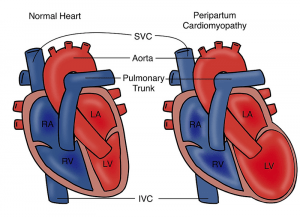Peripartum cardiomyopathy (PPCM) is a rare but serious form of heart failure that occurs during the last month of pregnancy or within the first few months postpartum. The condition is characterized by a reduction in left ventricular ejection fraction (LVEF), often accompanied by left ventricular dilatation and other structural changes in the heart. While the exact cause of PPCM remains unclear, several factors, including hemodynamic stresses of pregnancy, inflammatory processes, and genetic predispositions, are thought to contribute to its development.

Figure 1: PPCM is a diagnosis of exclusion, wherein patients have no prior history of heart disease and there are no other known possible causes of heart failure
PPCM is a disease that varies in incidence globally, with rates ranging from 1 in 1000 to 1 in 4000 live births in the United States. However, the condition is underdiagnosed due to its rarity and the non-specific nature of its symptoms, which overlap with typical pregnancy-related discomforts such as shortness of breath and fatigue. Pre-eclampsia, advanced maternal age, and multiparty are significant risk factors for the development of PPCM. In fact, the prevalence of pre-eclampsia in women with PPCM is four times higher than in the general population, highlighting the role of hypertensive disorders in exacerbating the condition.
Diagnostic tools like echocardiography, electrocardiography, and magnetic resonance imaging (MRI) are crucial for identifying PPCM early and managing its progression. Treatment strategies include standard heart failure therapies such as diuretics, beta-blockers, and angiotensin-converting enzyme inhibitors. However, special considerations must be made regarding the safety of these treatments during pregnancy and breastfeeding. Emerging therapies like bromocriptine, which inhibits prolactin, have shown promise in early studies, though larger trials are still underway. In severe cases, mechanical support or heart transplantation may be necessary.
Despite the seriousness of PPCM, over half of the women affected by the condition experience recovery within a year of diagnosis, with their LVEF normalizing. However, PPCM carries a high risk of relapse in subsequent pregnancies, making close monitoring and counselling essential for affected women considering future pregnancies.
Journal Article: Bala, Rajni, et al. “Peripartum Cardiomyopathy: A Review.” Revista Portuguesa de Cardiologia, vol. 42, no. 11, 1 Nov. 2023, pp. 917–924, www.sciencedirect.com/science/article/pii/S0870255123003578, https://doi.org/10.1016/j.repc.2023.01.029.
Summary by Faith Oluwamakinde










